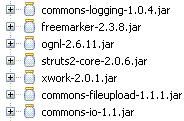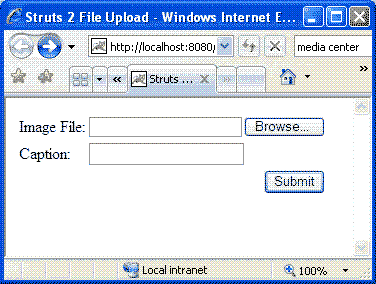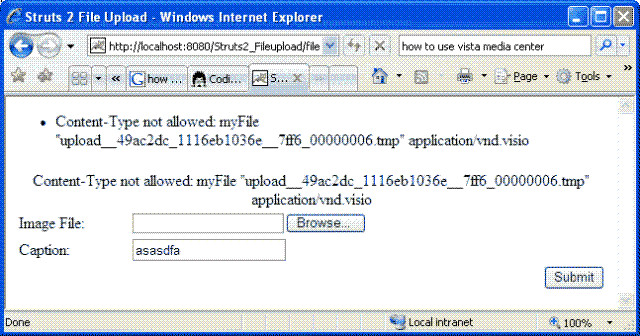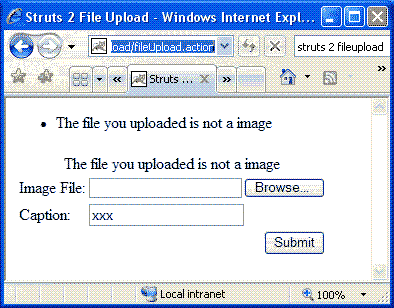前一陣子有些朋友在電子郵件中問關於Struts 2實現文件上傳的問題, 所以今天我們就來討論一下這個問題。 實現原理
Struts 2是通過Commons FileUpload文件上傳。Commons FileUpload通過將HTTP的數據保存到臨時文件夾,然後Struts使用fileUpload攔截器將文件綁定到Action的實例中。從而我們就能夠以本地文件方式的操作浏覽器上傳的文件。
具體實現
前段時間Apache發布了Struts 2.0.6 GA,所以本文的實現是以該版本的Struts作為框架的。以下是例子所依賴類包的列表:

清單1 依賴類包的列表
首先,創建文件上傳頁面FileUpload.jsp,內容如下:
<% @ page language = " java " contentType = " text/html; charset=utf-8 " pageEncoding = " utf-8 " %>
<% @ taglib prefix = " s " uri = " /struts-tags " %>
<! DOCTYPE html PUBLIC "-//W3C//DTD XHTML 1.0 Transitional//EN" "http://www.w3.org/TR/xhtml1/DTD/xhtml1-transitional.dtd" >
< html xmlns ="http://www.w3.org/1999/xhtml" >
< head >
< title > Struts 2 File Upload </ title >
</ head >
< body >
< s:form action ="fileUpload" method ="POST" enctype ="multipart/form-data" >
< s:file name ="myFile" label ="Image File" />
< s:textfield name ="caption" label ="Caption" />
< s:submit />
</ s:form >
</ body >
</ html >
清單2 FileUpload.jsp
在FileUpload.jsp中,先將表單的提交方式設為POST,然後將enctype設為multipart/form-data,這並沒有什麼特別之處。接下來,<s:file/>標志將文件上傳控件綁定到Action的myFile屬性。
其次是FileUploadAction.java代碼:
package tutorial;
import java.io.BufferedInputStream;
import java.io.BufferedOutputStream;
import java.io.File;
import java.io.FileInputStream;
import java.io.FileOutputStream;
import java.io.InputStream;
import java.io.OutputStream;
import java.util.Date;
import org.apache.struts2.ServletActionContext;
import com.opensymphony.xwork2.ActionSupport;
public class FileUploadAction extends ActionSupport {
private static final long serialVersionUID = 572146812454l ;
private static final int BUFFER_SIZE = 16 * 1024 ;
private File myFile;
private String contentType;
private String fileName;
private String imageFileName;
private String caption;
public void setMyFileContentType(String contentType) {
this .contentType = contentType;
}
public void setMyFileFileName(String fileName) {
this .fileName = fileName;
}
public void setMyFile(File myFile) {
this .myFile = myFile;
}
public String getImageFileName() {
return imageFileName;
}
public String getCaption() {
return caption;
}
public void setCaption(String caption) {
this .caption = caption;
}
private static void copy(File src, File dst) {
try {
InputStream in = null ;
OutputStream out = null ;
try {
in = new BufferedInputStream( new FileInputStream(src), BUFFER_SIZE);
out = new BufferedOutputStream( new FileOutputStream(dst), BUFFER_SIZE);
byte [] buffer = new byte [BUFFER_SIZE];
while (in.read(buffer) > 0 ) {
out.write(buffer);
}
} finally {
if ( null != in) {
in.close();
}
if ( null != out) {
out.close();
}
}
} catch (Exception e) {
e.printStackTrace();
}
}
private static String getExtention(String fileName) {
int pos = fileName.lastIndexOf( " . " );
return fileName.substring(pos);
}
@Override
public String execute() {
imageFileName = new Date().getTime() + getExtention(fileName);
File imageFile = new File(ServletActionContext.getServletContext().getRealPath( " /UploadImages " ) + " / " + imageFileName);
copy(myFile, imageFile);
return SUCCESS;
}
}
清單3 tutorial/FileUploadAction.java
在FileUploadAction中我分別寫了setMyFileContentType、setMyFileFileName、setMyFile和setCaption四個Setter方法,後兩者很容易明白,分別對應FileUpload.jsp中的<s:file/>和<s:textfield/>標志。但是前兩者並沒有顯式地與任何的頁面標志綁定,那麼它們的值又是從何而來的呢?其實,<s:file/>標志不僅僅是綁定到myFile,還有myFileContentType(上傳文件的MIME類型)和myFileFileName(上傳文件的文件名,該文件名不包括文件的路徑)。因此,<s:file name="xxx" />對應Action類裡面的xxx、xxxContentType和xxxFileName三個屬性。
FileUploadAction作用是將浏覽器上傳的文件拷貝到WEB應用程序的UploadImages文件夾下,新文件的名稱是由系統時間與上傳文件的後綴組成,該名稱將被賦給imageFileName屬性,以便上傳成功的跳轉頁面使用。
下面我們就來看看上傳成功的頁面:
<% @ page language = " java " contentType = " text/html; charset=utf-8 " pageEncoding = " utf-8 " %>
<% @ taglib prefix = " s " uri = " /struts-tags " %>
<! DOCTYPE html PUBLIC "-//W3C//DTD XHTML 1.0 Transitional//EN" "http://www.w3.org/TR/xhtml1/DTD/xhtml1-transitional.dtd" >
< html xmlns ="http://www.w3.org/1999/xhtml" >
< head >
< title > Struts 2 File Upload </ title >
</ head >
< body >
< div style ="padding: 3px; border: solid 1px #cccccc; text-align: center" >
< img src ='UploadImages/<s:property value ="imageFileName" /> ' />
< br />
< s:property value ="caption" />
</ div >
</ body >
</ html >
清單4 ShowUpload.jsp
ShowUpload.jsp獲得imageFileName,將其UploadImages組成URL,從而將上傳的圖像顯示出來。
然後是Action的配置文件:
<? xml version="1.0" encoding="UTF-8" ?>
<! DOCTYPE struts PUBLIC
"-//Apache Software Foundation//DTD Struts Configuration 2.0//EN"
"http://struts.apache.org/dtds/struts-2.0.dtd" >
< struts >
< package name ="fileUploadDemo" extends ="struts-default" >
< action name ="fileUpload" class ="tutorial.FileUploadAction" >
< interceptor-ref name ="fileUploadStack" />
< result name ="success" > /ShowUpload.jsp </ result >
</ action >
</ package >
</ struts >
清單5 struts.xml
fileUpload Action顯式地應用fileUploadStack的攔截器。
最後是web.xml配置文件:
<? xml version="1.0" encoding="UTF-8" ?>
< web-app id ="WebApp_9" version ="2.4"
xmlns ="http://java.sun.com/xml/ns/j2ee"
xmlns:xsi ="http://www.w3.org/2001/XMLSchema-instance"
xsi:schemaLocation ="http://java.sun.com/xml/ns/j2ee http://java.sun.com/xml/ns/j2ee/web-app_2_4.xsd" >
< display-name > Struts 2 Fileupload </ display-name >
< filter >
< filter-name > struts-cleanup </ filter-name >
< filter-class >
org.apache.struts2.dispatcher.ActionContextCleanUp
</ filter-class >
</ filter >
< filter >
< filter-name > struts2 </ filter-name >
< filter-class >
org.apache.struts2.dispatcher.FilterDispatcher
</ filter-class >
</ filter >
< filter-mapping >
< filter-name > struts-cleanup </ filter-name >
< url-pattern > /* </ url-pattern >
</ filter-mapping >
< filter-mapping >
< filter-name > struts2 </ filter-name >
< url-pattern > /* </ url-pattern >
</ filter-mapping >
< welcome-file-list >
< welcome-file > index.html </ welcome-file >
</ welcome-file-list >
</ web-app >
清單6 WEB-INF/web.xml
發布運行應用程序,在浏覽器地址欄中鍵入:http://localhost:8080/Struts2_Fileupload/FileUpload.jsp,出現圖示頁面:

清單7 FileUpload頁面
選擇圖片文件,填寫Caption並按下Submit按鈕提交,出現圖示頁面:

清單8 上傳成功頁面
更多配置
在運行上述例子,如果您留心一點的話,應該會發現服務器控制台有如下輸出:
Mar 20 , 2007 4 : 08 : 43 PM org.apache.struts2.dispatcher.Dispatcher getSaveDir
INFO: Unable to find 'struts.multipart.saveDir' property setting. Defaulting to javax.servlet.context.tempdir
Mar 20 , 2007 4 : 08 : 43 PM org.apache.struts2.interceptor.FileUploadInterceptor intercept
INFO: Removing file myFile C:\Program Files\Tomcat 5.5 \work\Catalina\localhost\Struts2_Fileupload\upload_251447c2_1116e355841__7ff7_00000006.tmp
清單9 服務器控制台輸出
上述信息告訴我們,struts.multipart.saveDir沒有配置。struts.multipart.saveDir用於指定存放臨時文件的文件夾,該配置寫在struts.properties文件中。例如,如果在struts.properties文件加入如下代碼:
struts.multipart.saveDir = /tmp
清單10 struts配置
這樣上傳的文件就會臨時保存到你根目錄下的tmp文件夾中(一般為c:\tmp),如果此文件夾不存在,Struts 2會自動創建一個。
錯誤處理
上述例子實現的圖片上傳的功能,所以應該阻止用戶上傳非圖片類型的文件。在Struts 2中如何實現這點呢?其實這也很簡單,對上述例子作如下修改即可。
首先修改FileUpload.jsp,在<body>與<s:form>之間加入“<s:fielderror />”,用於在頁面上輸出錯誤信息。
然後修改struts.xml文件,將Action fileUpload的定義改為如下所示:
< action name ="fileUpload" class ="tutorial.FileUploadAction" >
< interceptor-ref name ="fileUpload" >
< param name ="allowedTypes" >
image/bmp,image/png,image/gif,image/jpeg
</ param >
</ interceptor-ref >
< interceptor-ref name ="defaultStack" />
< result name ="input" > /FileUpload.jsp </ result >
< result name ="success" > /ShowUpload.jsp </ result >
</ action >
清單11 修改後的配置文件
顯而易見,起作用就是fileUpload攔截器的allowTypes參數。另外,配置還引入defaultStack它會幫我們添加驗證等功能,所以在出錯之後會跳轉到名稱為“input”的結果,也即是FileUpload.jsp。
發布運行應用程序,出錯時,頁面如下圖所示:

清單12 出錯提示頁面
上面的出錯提示是Struts 2默認的,大多數情況下,我們都需要自定義和國際化這些信息。通過在全局的國際資源文件中加入“struts.messages.error.content.type.not.allowed=The file you uploaded is not a image”,可以實現以上提及的需求。對此有疑問的朋友可以參考我之前的文章《在Struts 2.0中國際化(i18n)您的應用程序》。
實現之後的出錯頁面如下圖所示:

清單13 自定義出錯提示頁面
同樣的做法,你可以使用參數“maximumSize”來限制上傳文件的大小,它對應的字符資源名為:“struts.messages.error.file.too.large”。
字符資源“struts.messages.error.uploading”用提示一般的上傳出錯信息。
多文件上傳
與單文件上傳相似,Struts 2實現多文件上傳也很簡單。你可以將多個<s:file />綁定Action的數組或列表。如下例所示。
< s:form action ="doMultipleUploadUsingList" method ="POST" enctype ="multipart/form-data" >
< s:file label ="File (1)" name ="upload" />
< s:file label ="File (2)" name ="upload" />
< s:file label ="FIle (3)" name ="upload" />
< s:submit />
</ s:form >
清單14 多文件上傳JSP代碼片段
如果你希望綁定到數組,Action的代碼應類似:
private File[] uploads;
private String[] uploadFileNames;
private String[] uploadContentTypes;
public File[] getUpload() { return this .uploads; }
public void setUpload(File[] upload) { this .uploads = upload; }
public String[] getUploadFileName() { return this .uploadFileNames; }
public void setUploadFileName(String[] uploadFileName) { this .uploadFileNames = uploadFileName; }
public String[] getUploadContentType() { return this .uploadContentTypes; }
public void setUploadContentType(String[] uploadContentType) { this .uploadContentTypes = uploadContentType; }
清單15 多文件上傳數組綁定Action代碼片段
如果你想綁定到列表,則應類似:
private List < File > uploads = new ArrayList < File > ();清單16 多文件上傳列表綁定Action代碼片段
private List < String > uploadFileNames = new ArrayList < String > ();
private List < String > uploadContentTypes = new ArrayList < String > ();
public List < File > getUpload() {
return this .uploads;
}
public void setUpload(List < File > uploads) {
this .uploads = uploads;
}
public List < String > getUploadFileName() {
return this .uploadFileNames;
}
public void setUploadFileName(List < String > uploadFileNames) {
this .uploadFileNames = uploadFileNames;
}
public List < String > getUploadContentType() {
return this .uploadContentTypes;
}
public void setUploadContentType(List < String > contentTypes) {
this .uploadContentTypes = contentTypes;
}
總結
在Struts 2中實現文件上傳的確是輕而易舉,您要做的只是使用<s:file />與Action的屬性綁定。這又一次有力地證明了Struts 2的簡單易用。